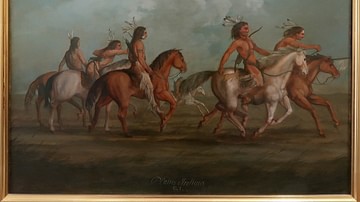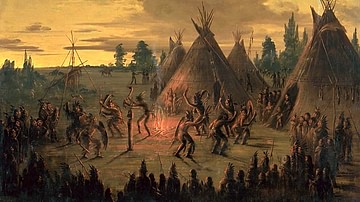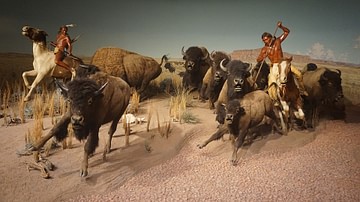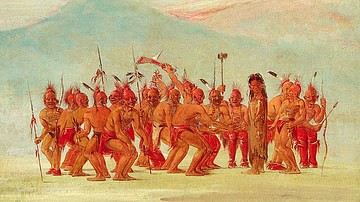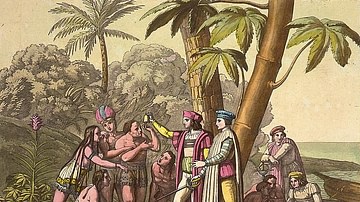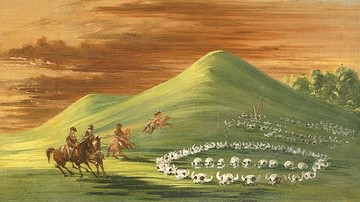Making the Sacred Bundle is an origin story of the medicine bag from the Pawnee nation. A medicine bag is a pouch or bundle containing items of resonant spiritual power for an individual or the tribal community that symbolize and maintain a relationship between the people and the spirit world and is regarded as sacred by Native Americans.
The term 'medicine' means 'spiritual power', which is derived, ultimately, from the supreme creative force in the universe, the Great Mystery or Great Spirit (known to the Pawnee as Ti-ra'wa, "Father Above"), although one might be directed to collect items for one's bag through dreams of one's ancestors or intimations received from the spirit of a given place, or one's own personal history and significant moments.
The bag/bundle may be as small as one's hand or as long as one's leg depending on what it contains. Individual medicine bundles are usually relatively small while a tribal bundle might be quite long and wide. Although medicine bags are frequently associated with medicine men (shamans), anyone who understands its meaning and the traditions associated with it can carry one.
Historically – and today – a medicine bag contains items that have meaning for the individual both personally and professionally. A medicine man or medicine woman might carry healing herbs, rattles, beads, or gems, a warrior could have arrowheads or flint for making fires, but anyone could have any of these as well as tobacco, sweet grass, sage, and any other items that have some meaning for the individual.
Each tribal nation has some form of a medicine bag and its own story of how it came to be. For the Pawnee, the bag was a gift from the son of a young man named Eagle Feather who married a buffalo-cow woman and, before leaving, the boy told his father that, as long as the people preserved the sacred bundle, the buffalo would always return, and they would never go hungry as the bundle would always offer communion between the people and their Creator-Provider.
The Pawnee & Sacred Bundle
The Pawnee were part of the Plains Indians and once lived in the regions of modern Kansas and Nebraska before being relocated to "Indian Territory", modern Oklahoma, where they reside today. As with other Native American nations, the Pawnee practice an earth-based religion, usually referred to as animism, in which the sacred bundle plays a significant role. The Pawnee, historically, were semi-sedentary, relying primarily on hunting for their subsistence but also planting maize (corn), beans, squash (the "three sisters" of Native American agriculture), pumpkins, and other crops. They chiefly relied upon maize and buffalo for food, and both of these came to factor in their religious beliefs as significant gifts from the Father Above.
Modern scholars refer to the Pawnee's emphasis on the sacred nature of corn as 'maize ceremonialism', which is best illustrated by the Green Corn Ceremony observed by many Native American nations, not just the Pawnee or other Plains Indians, celebrating the gift of corn, new life, and new beginnings. The sacred bundle, which was often made of buffalo hide and contained a sacred ear of corn, was part of the Pawnee origin myth that provided the people with their history and traditions like the Green Corn Ceremony. Scholar Michael G. Johnson writes:
Maize ceremonialism reached its highest development on the Plains among the Pawnee and Arikara…Before Euro-American influences had radically changed Pawnee culture, each village had its own origin myth. The village founder was created by a star or star group who had also provided the founder with a sacred bundle (a collection of paraphernalia such as rocks, feathers, corn ears, animal skins, etc.) which would form an altar around which the bundle's own ritual was performed. The bundle served as a source of power for good fortune and assistance for procuring food. In time, the bundle and paternal inheritance was passed on to his son, who was thus a descendant of the founder and new village chief. Since all the people of the village were regarded as the founder's descendants, they had a common origin and a common source of power. (157-158)
The sacred bundle not only grounded the people in their historical past but maintained their connection with the land on which they had received the gift and the Morning Star and Evening Star which were thought to have given birth to the first Pawnee woman. In some versions of the story, the first Pawnee man also came from these stars while, in others, he was the son of Moon and Sun. Ultimately, though, all things came from Ti-ra'wa, the Father Above, and so, as was common in Native American belief generally, all things were related; which is how all of the Pawnee were regarded as descendants of the first man and everyone in a village as family, even though they had different clans.
The sacred bundle itself was not worshipped, nor was the ear of corn nor any other tangible item, but represented the ineffable nature of Ti-ra'wa, who joins all things in the world in a relationship of equals, although, often, animals are shown to possess greater wisdom and understanding than humans (a common motif in Native American stories generally).
In Making the Sacred Bundle, Eagle Feather is already an accomplished hunter when the story begins, but he owes his later success to the buffalo-cow woman who becomes his wife and the mother of his son. The story emphasizes the wisdom and power of both the son and the buffalo-cow woman over Eagle Feather's, also a common theme in Native American literature, reflecting the high regard in which the culture held women and children.
Text
The following text comes from Voices of the Winds: Native American Legends by Margot Edmonds and Ella Clark as reprinted from Myths and Legends of the Pawnee by the Scottish folklorist Lewis Spence.
Long ago, a young Pawnee named Eagle Feather was very proud of the way he looked. He wore the best clothes and the richest ornaments he could find. Always when he hunted, he wore a magic downy eagle feather in his hair. He was not married, though many of the young Indian girls admired his handsome appearance.
One day while hunting with his companions, Eagle Feather became separated from the others, but continued to follow some buffaloes for a long distance. All of the animals escaped him except one young buffalo-cow, which had become stuck in a mudhole. When Eagle Feather aimed his arrow to shoot, the buffalo-cow suddenly vanished and, in its place, stood a pretty young woman.
Eagle Feather was astonished. He could not understand where the buffalo had gone, or from where the girl had come. They talked together and became friends. She did not want to return with him to his tribe when he asked her to marry him. Eagle Feather agreed to remain there with her and she became his wife. For a wedding gift, he gave her a blue and white string of beads, which she always wore around her neck.
They made a camp there and were very happy together. One day, Eagle Feather returned from hunting to find that his camp had disappeared, his wife was missing, and marks of many buffalo hooves covered his campsite. Since he could not find his wife anywhere, Eagle Feather returned to his Pawnee tribe.
After a few years passed, one summer morning Eagle Feather and his friends were playing stick ball. A little Indian boy came toward them, wearing around his neck a string of blue and white beads.
"Father," he said to Eagle Feather. "Mother wants you to follow me and I will take you to her."
"Go away," replied Eagle Feather. "I am not your father."
When the little Indian boy ran back to the woods, Eagle Feather's companions laughed at the boy calling him father. They thought Eagle Feather had never married.
In a little while, the boy returned from the woods. Again, he was told to go away, but one of the men said to Eagle Feather, "Maybe you had better go with the child and see what he wants."
All of this time, Eagle Feather had been wondering, "Where have I seen those blue and white beads before?" Suddenly, in his mind's eye, he saw a buffalo-cow and a calf running across a prairie. He then remembered the blue and white beads he had given the buffalo-maiden for a wedding present.
Taking his bow and arrows with him, he followed the two buffaloes that he now believed were his wife and child. A long and weary chase followed, because the woman was angry that first he had denied the boy's request. As she ran, she magically dried up every creek they passed. Eagle Feather thought he was going to die of thirst. But his son secretly left some food and water for him along the way, until they arrived at the home of the buffaloes.
The big buffalo-bulls were the herd leaders. They became angry with Eagle Feather for marrying the buffalo-cow. They wanted to kill him. But first they would test him. Six buffalo-cows were lined up in a row, all looking exactly alike. Eagle Feather was to point out his wife. His son helped him secretly, and Eagle Feather correctly chose his wife.
Surprised, the old bulls gave Eagle Feather another test. This time, several calves were placed in a row, and Eagle Feather was to choose his son. Again, the child secretly helped his father point out the right one. Then the bulls decided that Eagle Feather must run a race against the fastest buffaloes.
On the day set for the race, a freeze occurred, and the buffaloes could not run well on the slippery ground. Eagle Feather ran swiftly and won the race.
Now the chief bulls grew angrier, and they determined to kill Eagle Feather. He was told to sit down on the ground in the center of a circle surrounded by buffalo-bulls. Upon a signal from the Chief, the buffaloes charged Eagle Feather. His magic feather was seen floating above the confusion that followed.
When the Chief called a halt to the charge, he expected to see Eagle Feather trampled to death. The bulls withdrew and there sat Eagle Feather in the center of the ring with his magic feather still in his hair.
A second charge of the buffalo-bulls ended with the same result as the first. Deciding that Eagle Feather possessed powerful magic-protection, the Chief welcomed him into their camp on one condition: that he bring them gifts from the Pawnee tribe. This, Eagle Feather agreed to do.
When he returned to his tribal village with his wife and son in human form, he found his people without food. But his wife had brought some buffalo meat under her robe, and, magically, every one of the Pawnees had enough to eat. Later, when Eagle Feather and his family took gifts to the buffalo leaders, they were greatly pleased.
In return, the leaders offered some of their old bulls to help the Pawnees secure more food. The young son of Eagle Feather returned with the herd in the form of a yellow calf, while his parents went ahead in human form.
"Do not kill the yellow calf," warned Eagle Feather. "When you hunt, always save the yellow calf, because it will always bring back more buffaloes to the Pawnee tribe."
Consequently, they had an abundance of food for a long time. Then one day, the son of Eagle Feather said to his father, "No more will I visit you as a boy. No longer should the hunters spare the yellow calf. They should kill it and sacrifice it to the Great Spirit. They should tan its yellow hide and make a bundle containing an ear of corn and other sacred objects wrapped within. This will be your tribal sacred bundle."
"Every year, you must look for another yellow calf leading the buffalo herd to the Pawnees. Each year you must sacrifice it and keep a piece of its fat, adding it to your sacred bundle."
"Then if food ever should become scarce, your chiefs should gather in council and pay a friendly visit to a young buffalo. He will tell of your need to the Great Spirit, so that another yellow calf might be sent to lead a buffalo herd to the Pawnees."
When he had finished speaking, the boy left the camp. In the future of the Pawnee tribe, everything happened as he said it would. Food was plentiful, Eagle Feather became a great Chief, respected and loved by his tribe. His buffalo-wife, however, was almost forgotten, and one night she vanished forever.
Chief Eagle Feather felt great remorse when he came to realize his neglect of her. He never recovered fully from the loss of his wife. In time, he withered away and died. His magic eagle feather was added to the sacred bundle of the Pawnee tribe.
The Pawnees' sacred bundle has long been preserved by the tribal shaman for its magic charms, which always bring back the buffaloes. The Pawnees knew that in a time of great need, the sacred bundle could be opened by the tribal priest in a proper solemn ceremony, imploring the help of the Great Spirit.
Conclusion
The story has been interpreted as an allegory of the rite of human sacrifice practiced by the Pawnee known as the Morning Star Ritual in which a young woman captured from another tribe would be sacrificed in the spring to renew the earth with her blood. This interpretation points to the conclusion where Chief Eagle Feather forgets his wife and withers away, just as the Pawnee who continued to support the Morning Star Ritual in the 19th century claimed they would decline if the rite was abandoned, which many Pawnee, influenced by white settlers, advocated for.
It has also been interpreted as an allegory of the arrival of the morning star in the form of the yellow buffalo who gives the people their sacred bundle, allowing for continued communion with Ti-ra'wa and a source of strength and power for the people. At first, the yellow calf is to be spared but, after the sacred bundle is made, it should be sacrificed and a piece of its fat added to the bundle, perhaps symbolizing the presence of the Morning Star among the people.
At its simplest level, though, the story tells of how the medicine bag/sacred bundle came to the Pawnee, explaining and clarifying its sacred origin and purpose. The medicine bag was famously carried by a medicine man or medicine woman but, as noted, could be made and carried by anyone of the tribe who would, naturally, have been raised with an understanding of its meaning and importance.
Unfortunately, like many Native American practices, the medicine bag has been appropriated by non-Natives, often for commercial purposes, as noted by scholar Adele Nozedar:
[The medicine bag or pouch] is used to contain various items that are considered to be magical…Latterly, though, the medicine bag has become relatively popular among non-Native people, and it seems that anyone can concoct a medicine bag and fill it with items that are meaningful to him or her…Medicine bags are now made commercially and can even be specially commissioned, but traditionally the bag is made by its owner, from skin or hide. (282-283)
Like the sweat lodge, and many other customs and traditions of the Native Americans, the medicine bag is frequently exploited by non-Natives for their own purposes, most often financial gain. The Pawnee and other Native American nations continue to make their own medicine bags and keep their tribal sacred bundle in the present day while reminding non-Natives of its traditional importance to indigenous people.



